
My grandmother, Nana (Marion Rosalind Hickson), descended from a couple named William Thomas Hickson and Sarah Mabin Hickson, her grandparents. William and Sarah were part of a trio of Hickson siblings who left England and emigrated to Canada in the mid-nineteenth century in search of a better life. With the growing treasure trove of documents becoming available, we’ve discovered a lot about these settlers, their lives in England, and the resources they used to make this journey. We’ve made discoveries about their lives in Canada and the eventual migration to the United States for a few of them. But every story has to have a beginning and it is best to begin the story of this family in London, England where we have the first indisputable, documentary evidence of their lives.
Hickson is a fairly common name in England. Combine that with given names like William, Samuel, and Thomas and you can see the difficulty of tracing a family and being certain that you have the right people. There have been church parish records since 1538 in many places and these often list important details. However, it wasn’t until the first decennial Census of England began in 1841 that we could find families grouped together with members listed individually along with details of their occupations, ages, addresses, birthplaces, names and ages of children and exactly where they lived. It turns out that this is the point (1841) where we become certain that we have found our own Hickson family.
The Hicksons.
Here is a “Raindrop” Chart for Samuel and Frances Hickson, my 3rd great-grandparents – and maybe yours also. This chart shows the six children of Samuel and Frances and the raindrops below each name represent the surnames of three generations of their descendants – in no particular order or hierarchy. A way to quickly find your ancestor without wading through a complicated, multigenerational –often multipage — diagram.

So, let’s get started…..The family of Samuel Hickson.
My 3rd great-grandfather was Samuel Hickson, born sometime around 1776. Because we are not certain of his exact birth date or place of birth, we can’t be certain of his parentage. That is why we must begin our story with events that we can document with some degree of certainty — Samuel’s marriage and the start of his family.
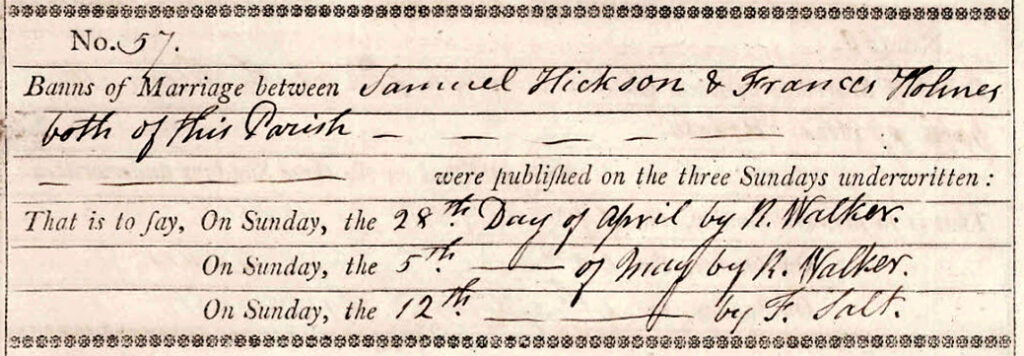
Samuel Hickson married Frances Holmes in Wem, Shropshire on May 16, 1816. Their firstborn son, Samuel Richard, was born in Wem, Shropshire exactly ten months later on March 16, 1817. Wem, Shropshire is a good 180 miles northwest of London, between Birmingham and Liverpool. So, how did it happen that this couple married in Wem? Frances was born in London and Samuel was born elsewhere. It could have been in Wem (although there is no record of such). We just don’t know at present. However, at that time of the early 1800’s, it was very common for young men to enter into apprenticeships all over the country to learn a craft and hone their trade. So we can speculate that Samuel was in Wem learning a trade when he married Frances and they had their first child.
By 1818, the Hicksons were in London. Their second son, William Thomas, was born on August 26, 1818, and was baptized at St. Botolph’s Aldgate parish church, just north of the Thames River. Joseph followed in 1819, and his baptism was across the river at Southwark St Saviour. Joseph lived less than a year and was buried at St. Saviour. Next came Eliza in 1821, and she was also baptized at St. Saviour. Another son, also named Joseph was born in 1823 and christened at St. Saviour. It was not uncommon to name a subsequent child the same name as a child who had died. Finally, George Hickson was born in August of 1825, and he perished two months later. He, too, was baptized and buried at St. Saviour. We can safely assume that this young family lived in Southwark on the south side of the Thames in the county of Surrey, effectively a suburb of London, and were actively assigned to the parish of St. Saviour — at least into the mid-to late 1820’s.
By the 1841 census, Samuel and his family were in a working class area of London called the Tower Hamlets in the Stepney subdistrict of the larger Hackney district. They lived on Greenfield Street (now Greenfield Road). The Hickson family household in 1841 consisted of Samuel (60) and Frances (50) and second son, William (20), and daughter, Eliza (17). Their eldest son, Samuel Richard, had already left home in 1841. There is no mention of Joseph who would have only been 16, but that could have been an oversight or Joseph could have already started an apprenticeship. Also, in the household were three men, two of whom were named Holmes — possibly Frances’ brother and nephew.
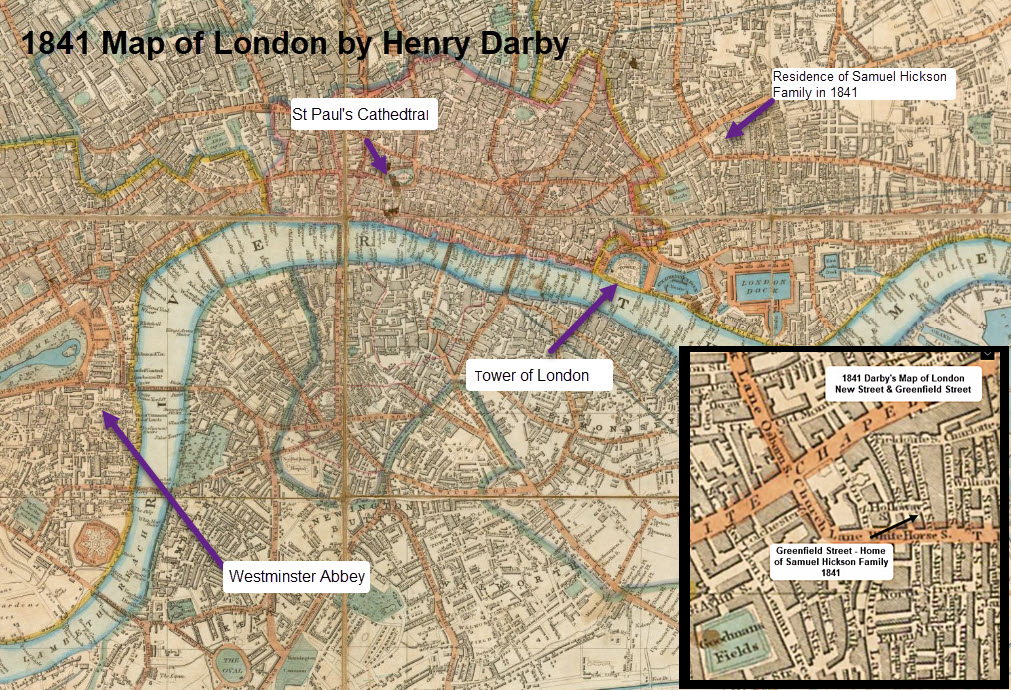
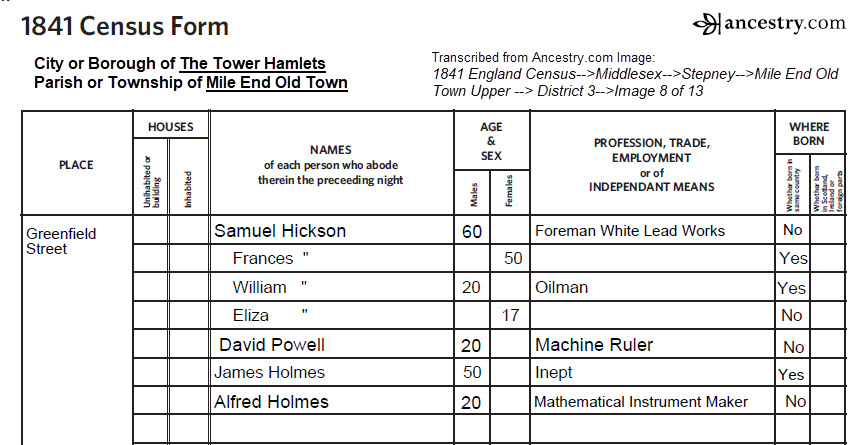
Samuel (or whoever responded to the census taker) declared his occupation as a Foreman in a White Lead Works Factory. At this time, White Lead (lead carbonate), a powder, was the primary pigment in white paint. It is manufactured from exposing pure lead strips to various weak acids and harvesting the resultant white powder. The toxicity of lead was well-known by the early 1800’s and white lead factories typically employed women, because it was thought that women were less susceptible to lead poisoning. White lead paint (pigment mixed with turpentine and linseed oil) had waterproofing qualities and was used on most wood surfaces subject to weathering including the decks, masts, and other wood surfaces of Royal Navy ships. So the product was in high demand and a foreman was probably a respectable position. Here is a description of a the White Lead Works of Southgate Road located in the greater Hackney area where the Hicksons resided in 1841.
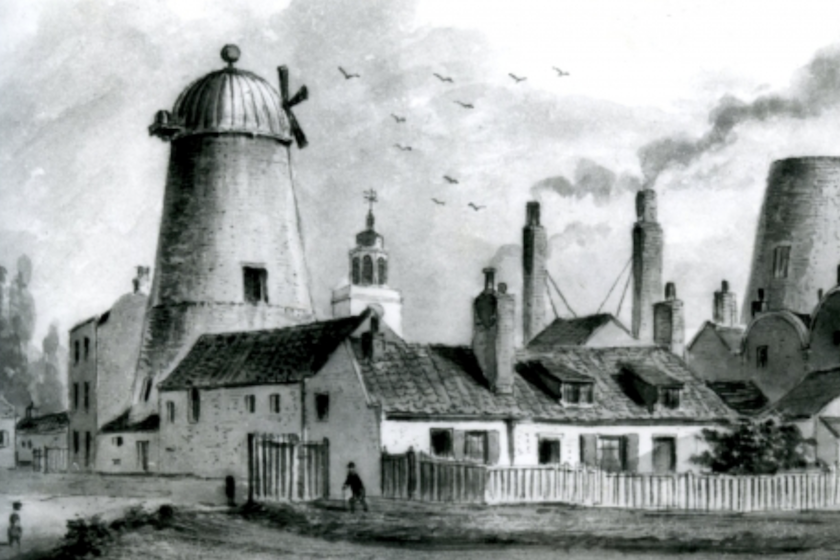
Samuel Hickson died July 31, 1848 at the age of 72 of a diseased prostate, from which he had suffered for many years. (Environmental lead exposure can contribute to prostate cancer risk.) He had been in a coma for five days before he passed. At the time of his death, he was living at 52 Victoria Street in the neighborhood of Homerton. His youngest son, Joseph, was present when his father died and acted as the informant. Samuel’s death and burial are documented in a registry for St. Thomas Square Burial Ground on Mare Street in the parish of Hackney. There is a large burial ground still existing at St. Thomas Square, but the land was converted to a public garden in 1888 and the headstones were dislodged and scattered around the perimeter walls.

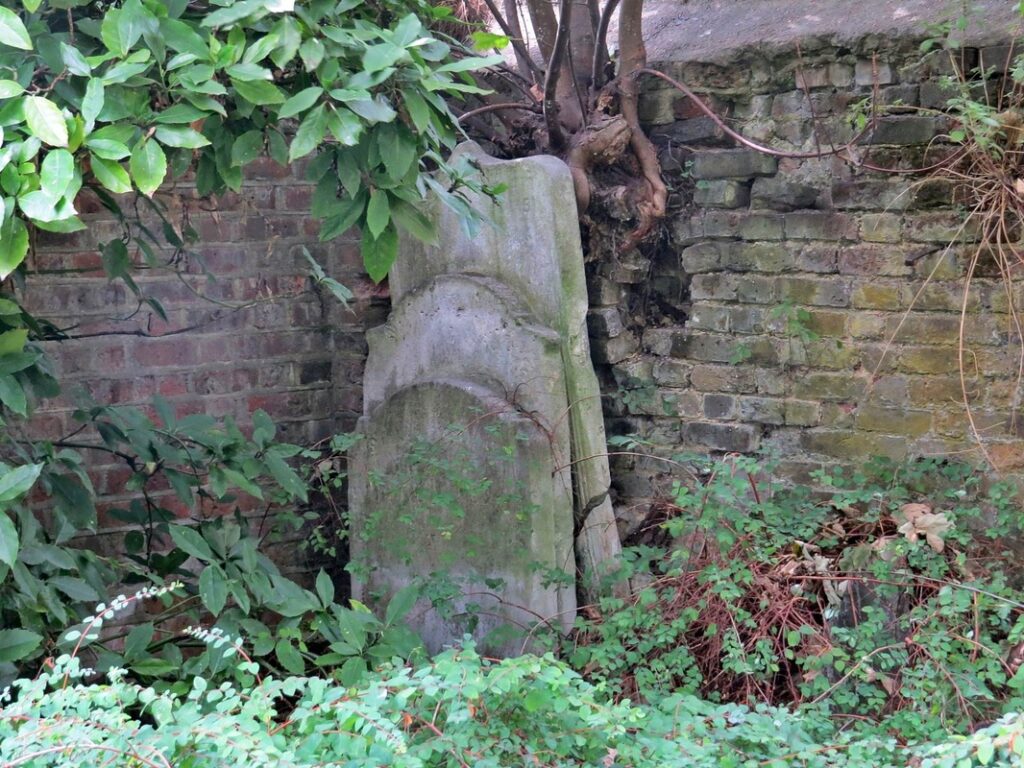
The next generation of Hicksons – briefly, for now.
The four surviving children of Samuel and Frances began their adult lives in the Hackney area of London in the 1840’s. Times were difficult and we have no indication that they were anything but members of the tenuous working class — starting as employed tradesmen but always teetering on the brink of poverty. Each took a slightly different occupational path, and none followed their father in the White Lead business. The eldest three eventually emigrated to Canada, two with assistance from the Hackney Workhouse – a testament to their circumstances. Only Joseph remained to live out his life in London. Here is a very brief account of each child, with more detail to come in later posts.
The eldest son, Samuel Richard Hickson married Harriett Mabin in October 1841 in Surrey, near London. Samuel was a hatter – maker of hats. Harriett was a waistcoat seamstress. That both of them were in the clothing industry might explain how they met. Samuel and Harriett first lived in Woolwich, Kent and then in Liverpool before returning to London in 1846. They had eight children, five born before they emigrated to Canada in 1855 and three born in Canada.
Second son, William Thomas Hickson, married Harriett Mabin’s sister, Sarah Mabin, in January of 1842. In 1841, William’s occupation was listed as Oilman – supplier of the fuel for lamps. Like her sister, Sarah was a waistcoat maker. William and Sarah had 3 children, Frances Annie, Clara, and William Samuel, my great-grandfather. William went to Canada in 1848 or 1849 and the family went to join him in 1850.
Daughter Eliza Hickson married Hugh Lawson, a tailor, in July 1848, just 3 weeks before her father passed away. Hugh was a widower and had a 3-year-old daughter when he married. Eliza and Hugh emigrated to Canada soon after their wedding and they had all four of their children in Ontario. (see Hugh Lawson below.)
Son Joseph started out in the grocery trade. His first wife was named Elizabeth and they married in 1850. In 1851, this couple was living in St Clement Danes area of London with Joseph’s employer, a Grocer named Andrew Heap. Joseph and Elizabeth had no children and she died in 1852. Joseph then married Ann Lyde in 1855 and they settled in the Bermondsey Parish of Southwark, Surrey. Joseph and Ann had five children, four daughters and a son who died young. Ann died in childbirth with the youngest daughter in 1866. Joseph remarried again in 1873 and lived the rest of his life in Islington, until his death in 1900. After 1871, his occupation was listed as “Commercial Traveller” – a person who traveled on horseback to distribute goods to retailers or manufacturers.
The eldest three children, Samuel, William, and Eliza emigrated to Canada. Joseph always remained in London.
The Mabins.
For those of us descended from Samuel Richard and William Thomas, the Mabins are also our 3rd great-grandparents – as they are the parents of Sarah Mabin, William Thomas’ wife AND Harriett Mabin, Samuel Richard’s wife.
Roger Elliott Mabin was born in October 1788 in Devonshire to Austin Mabin and Margaret Elliott Mabin, both from Devonshire. Roger’s future wife, Sarah Phillips, was born in 1786 to Joseph and Ann Phillips, also from Devonshire. Roger and Sarah were married September 1813 in Charles the Martyr Church in Plymouth, Devon. They had 3 children. A son, Robert Mabin, was born in 1814 in Plymouth and lived until he was 6 years old. Daughter Harriett was born in 1818 in Devon and daughter Sarah was born in 1821 in London (St. Pancras). Both of these daughters married sons of Samuel and Frances Hickson. This make descendants of Samuel Richard and William Thomas, “double cousins”, which is what happens when sisters marry brothers — two sets of common ancestral couples — when, ordinarily, cousins only have one ancestral couple in common!!
In the 1841 census, Roger’s occupation was Joiner – an artisan or tradesperson who built items, usually small ornamental pieces, by “joining” pieces of wood – a wood-worker. In 1861 in Canada he was listed as a Carpenter.
Roger and Sarah Mabin traveled to Canada with Frances Holmes Hickson and their daughter Sarah Mabin Hickson in May 1850.
Hugh Lawson.

Hugh Edwin Lawson was the husband of Eliza Hickson, the only daughter of Frances and Samuel Hickson. They married July 6, 1848. The witnesses on their certificate were her parents, Samuel and Frances Hickson. Hugh Lawson is listed as a “Widower”. This wedding occurred only 3 weeks before Eliza’s father, Samuel Hickson, passed away on July 31, 1848.
So, in the 1841 Census, Hugh Lawson was 29 years old, single, living on Charlotte Street in the St Pancras neighborhood of London, and was working as a Tailor. His birthplace was Scotland. In the first quarter of 1844, Hugh Lawson married Mary Tailby Wilkinson.

Mary and Hugh had a daughter, Mary Jane, who was born December 28, 1844. But, Mary Tailby Lawson passed away on May 18, 1848 leaving Hugh with a 3-year old daughter. Barely 6 weeks later, Hugh Lawson married Eliza Hickson.
We believe that Hugh and Eliza left for Canada fairly soon after their marriage. We have not found any evidence that they requested Workhouse support for their travel funds, like the other two Hickson sons did. But those records don’t exist yet for 1848 – 1849. We know they were in Canada by August 1849 when their daughter, Frances, was born. Frances always maintained her birthplace was Ontario.
What may or may not be well known among Hickson descendants is that Hugh’s young child, Mary Jane Lawson, definitely accompanied Hugh and Eliza to Canada, and was raised with their other four children. When Mary Jane married Richard Dunn in 1869 in London, Ontario, Eliza Lawson was the witness on her step-daughter’s wedding register.
